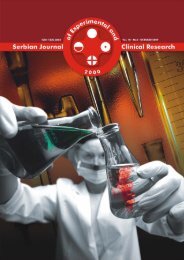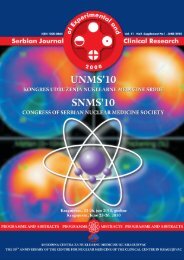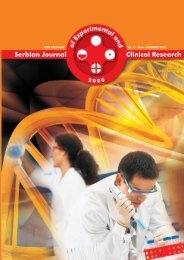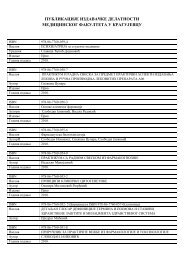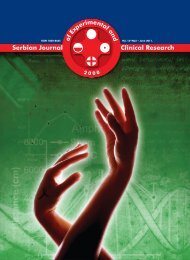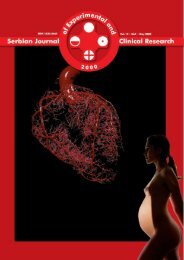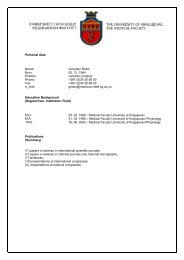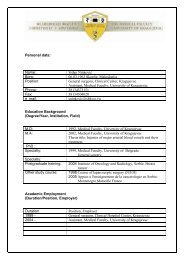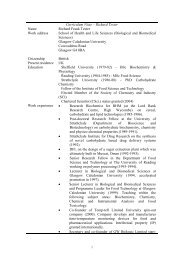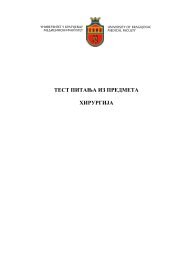neurotoxicity and mechanisms of induced hyperexcitability
neurotoxicity and mechanisms of induced hyperexcitability
neurotoxicity and mechanisms of induced hyperexcitability
Create successful ePaper yourself
Turn your PDF publications into a flip-book with our unique Google optimized e-Paper software.
1 -The primary site fragmentation process <strong>and</strong> its majorfragmentation pathways in both techniques.2 -The stability <strong>of</strong> the drug as a neutral molecule in thesolid-state phase <strong>and</strong> molecular ion in the gas phase.3 -Selection <strong>of</strong> the most probable decomposition pathwayin both TA <strong>and</strong> MS.Thermal analysis (TA)The TG/DTA curves <strong>of</strong> DMP (Fig. 2) were displayed between25ºC <strong>and</strong> 600ºC. The drug has the general formulaC 18H 25NO.HBr.H 2O in solid-state phase with a molecularweight (MW) <strong>of</strong> 370.3 <strong>and</strong> melting point (m.p.) 125 ºC.It is clear from the thermal survey <strong>of</strong> the drug that thereare four mass losses in the TGA (Table 1). The first oneappeared at 100-150ºC with a mass loss % <strong>of</strong> 4.1, whichmay be attributed to the loss <strong>of</strong> water present in the drug(cal. mass loss % = 4.8). The second mass loss was approximately32.5% <strong>and</strong> occurred at 150-350ºC. The third onewas 54.57% <strong>and</strong> occurred at 350-450ºC. The final one was5.68% <strong>and</strong> occurred at 450-600ºC, which may be attributedto the loss <strong>of</strong> the remainder. These mass losses were observedat the three main peaks at values: 120.8ºC, 287.2ºC<strong>and</strong> 378.6ºC in DTG, respectively. These mass losses alsoappeared as two endothermic peaks in the DTA. The firstone appeared at 110.77ºC, requiring an energy E 1= +242.6J/g, <strong>and</strong> the second one appeared at 362ºC, requiring anenergy E 2= + 356.75 J/g. The fragmentation <strong>of</strong> this compound<strong>and</strong> its chemical changes occurring after this thermaldegradation appeared at 555.56ºC as a very strong exothermicpeak requiring an energy E 3= 513.5 J/g.Fig.2a : TGA curve <strong>of</strong> Dextromethorphan HydrobromideFig.2b : Dr.TGA <strong>of</strong> Dextromethorphan HydrobromideMass spectral behaviour <strong>of</strong> dextromethorphan (MS)The electron impact (EI) mass spectrum for DMP drugat 70 eV was recorded <strong>and</strong> investigated. A typical massspectrum (barograph) <strong>of</strong> the drug is shown in Fig. 3.Scheme 1 shows the proposed principal fragmentationpathways <strong>of</strong> DMP following electron impact at 70 eV. Inaddition, prominent ions <strong>and</strong> their relative intensities withsome common ions formed from codeine [26] are listedFig 2 C: DTA <strong>of</strong> Dextromethorphan HydrobromideTable 1: Structure identification <strong>of</strong> Dextromethorphan HydrobromideTGADTAWt. loss% Temp.range o C Peak temp. o C Descripion E J/g4.10 100-150 118.77 Endothermic +242.632.50 150-350 367.6 endothermic +365.7554.57 350-450 555.56 St.exothermic peak -613.55.68450-600ΣWt.loss %=96.85*Dr. TGA gives three main peaks temperatures at 120.58, 287.23 <strong>and</strong> 378.62 oC.23



